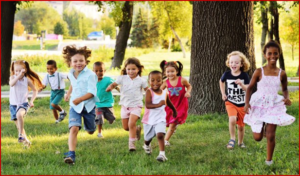Climate change-related effects in childhood can have lifelong consequences due to effects on learning, physical health, and housing security, according to an EPA report released today. The new national-scale, multi-sector EPA report shows some of the ways children are especially vulnerable to a variety of health effects from climate change due to physical, cognitive, behavioral, and social factors.
“Understanding health risks to children is critical for developing effective and equitable strategies that will protect our current and future generations,” said EPA Administrator Michael S. Regan. “Today’s report will help further efforts being taken by the Biden Administration across the Federal government to address the climate crisis and advance environmental justice.”
The report comes at a time when sleeping Republicans have proposed a solution to the national debt crisis they induced that rewards fossil fuel interests. Most of the Republican party at the national and state governing levels have long denied Climate Change and continue to do so as the evidence for its harmful effects grows increasing irrefutable.
The peer-reviewed EPA report quantifies projected health effects associated with extreme heat, air quality, changing seasons, flooding, and infectious diseases. Where possible, the analyses consider the extent to which health effects disproportionately fall on children who are Black, Indigenous and people of color [BIPOC], low income, without health insurance, and/or have limited English proficiency.
The report finds several impacts to US children’s health and well-being. For example, at 2°C and 4°C of global warming:
- Climate change is expected to increase the incidence of asthma in children. Specifically, climate-driven changes in air quality are estimated to increase annual cases of asthma by between 4% and 11%, respectively.
- Increases in oak, birch, and grass pollen are projected to increase children’s asthma-related emergency department visits from 17%-30% each year.
- Additional cases of Lyme disease in children are projected to rise 79% to 241%, or an additional 2,600 to 23,400 new cases per year.
- Heat experienced during the school year affects concentration and learning in children. Climate-driven temperature increases are projected to result in 4% to 7% reductions in annual academic achievement per child. These learning losses can affect future income, with potential losses across cohorts of graduating students reaching billions of dollars annually (and in the thousands of dollars per individual).
- If no additional adaptation actions are taken, 1 million to 2 million+ children are estimated to experience temporary home displacement or complete home loss, respectively, from coastal flooding at 50cm to 100cm of global mean sea level.
EPA will host a public online seminar on 22 May to discuss the report. To access the report and associated materials or register for the webinar, go to the Climate Change and Children’s Health and Well-Being in the United States Report webpage.
AutoInformed on
- President Biden at COP 27 Pledges US Leadership on Solving the Climate Crisis
- SEC – New Rules on Climate-Related Disclosures for Investors
- Draining the Swamp – California, 22 States Sue to Stop Trump Emissions Rollback Citing Economic, Health and Climate Goals
- UN on Global Warming: Rapid, Far-Reaching Unprecedented Changes in All Aspects of Society Needed
- CARB Environmental Justice Advisory Committee Renewed
- Pure EV Sales at All-Time Record in US
- Dutch Court Rules Shell Must Cut Greenhouse Gas Emissions
- EVs, Coal Plant Closings Can Cut Carbon Emissions 42%



Today marks the one-year anniversary of the Justice Department’s Comprehensive Environmental Justice Enforcement Strategy and Office of Environmental Justice. To mark the anniversary, the Department has issued a fact sheet highlighting its progress in its work advancing environmental justice.
“In the year since I announced the creation of the Justice Department’s first Office of Environmental Justice, the Department has taken important actions across the country to advance environmental justice for all Americans– including working to improve access to safe drinking water in Jackson, Mississippi; curbing harmful pollution in Louisiana’s ‘Cancer Alley’; and securing convictions for mismanagement of industrial waste in West Virginia,” said Attorney General Merrick B. Garland. “Although violations of our environmental laws can happen anywhere, communities of color, indigenous communities, and low-income communities often bear the brunt of the harm caused by environmental crime, pollution, and climate change. We will continue to seek justice for and protect communities that are disproportionately burdened by environmental harms.”
“Our accomplishments over the past year confirm that advancing environmental justice is core to the Justice Department’s mission,” said Associate Attorney General Vanita Gupta. “All Americans, no matter where they live or work, deserve the protection of federal laws protecting clean air, clean water, worker safety, and quality of life.”
“I am proud of the progress we have made this year,” said Assistant Attorney General Todd Kim of the Justice Department’s Environment and Natural Resources Division. “I look forward to deepening our partnership with EPA and other federal agencies as we strive to bring relief to overburdened communities, and to ensure that every American has clean water to drink and clean air to breathe.”
“Black communities and other communities of color are far too often disproportionately impacted by unsafe drinking water, illegal dumping, and other environmental hazards and injustices,” said Assistant Attorney General Kristen Clarke of the Department’s Civil Rights Division. “As our recent agreement in Lowndes County makes clear, we are committed to using our federal civil rights laws to address environmental injustices that have plagued our most vulnerable communities for generations.”
“As we take this opportunity to reflect on the Department’s ongoing efforts to advance environmental justice, we know there is more work to do,” said Director Cynthia Ferguson of the Justice Department’s Office of Environmental Justice. “It is a privilege and an honor to engage with communities across America as we work towards a healthier, safer world for all.”